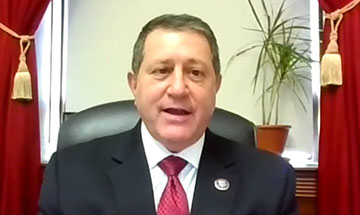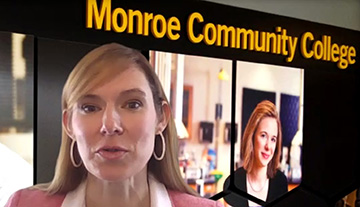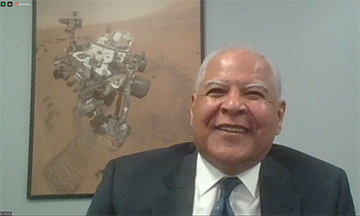
U.S. Rep. Joe Morelle
On 24 February, the U.S. Congressional Optics & Photonics (O&P) Caucus held a virtual launch event, officially introducing the newly formed caucus to an audience of 324 attendees. The O&P Caucus seeks to educate members of U.S. Congress about the importance of optics and photonics, and to encourage public and private investment in the research, technologies and workforce in this field.
Caucus co-founder and chair Rep. Joe Morelle (D-NY), who hails from the U.S. optics hub of Rochester, kicked off the event by speaking to his personal history with the field of optics—saying that he was surprised when he came to Congress “by the siloed knowledge of the capabilities of light-based technologies.” Which is why, he explained, this caucus is important “to educate our colleagues, create opportunities to connect with constituents and policy experts, and to collaborate to ensure the United States remains a leader in optics and photonics for light years to come.”
Government, academic and industry partners
Appropriately, the diverse slate of speakers reflected this call for collaboration, with talks spanning biophotonics, national security and optics education. First up was Bruce Tromberg, director of the National Institute of Biomedical Imaging and Bio-engineering and head of the Rapid Scaling Up of COVID-19 Diagnostic Testing in the U.S.—graciously abbreviated as the RADx Initiative. Speaking from a biophotonics point of view, Tromberg explored the impact that optics and photonics technologies have had in advancing cutting-edge methods, discoveries and devices in biology and medicine.
Using coronavirus as a case study, Tromberg said that when the RADx Initiative was funded, he knew that “we had game-changing optics and photonics technologies that were ready to jump from research labs to the marketplace. But these methods needed to be combined with molecular assays and undergo intensive de-risking and validation prior to investment.”
As of today, RADx has invested US$520 million in 27 companies for manufacturing expansion, and that “virtually all of these platforms depend on optics and photonics technologies to reveal the presence of an invisible virus.” According to Tromberg, this shows how biophotonic advances and government–academia–industry partnerships can dramatically change the world.
Training an optics workforce

MCC optics professor Alexis Vogt
Next, Adele Ratcliff, U.S. Department of Defense, spoke to how much the precision-optics space has expanded for security applications—from “boutique status” to a “broadly proliferated technology” that’s now found in every weapon system. This massive growth, she said, has been followed by a surge in precision-optics manufacturing, causing fierce competition for this labor. Her focus, she maintained, is “to be able to promote the prestige of those workers coming into this exciting technology front, accelerate them through their development pipelines and elevate them to world-class standards.”
As an optics professor at Monroe Community College (MCC) in Rochester, NY, the only two-year program for training optics technicians in the U.S., Alexis Vogt echoed Ratcliff’s call for a well-trained optics workforce. Vogt began her talk with some startling statistics that demonstrated the massive workforce gap in optics and photonics.
One in 14 households in Monroe county, she said, is supported by the optics industry, and the Finger Lakes region of New York alone has an annual demand for 550 optics technicians. Although MCC’s fall enrollment is at an all-time high, said Vogt, “that is not enough to fill even our local workforce need, let alone the entire country.”
Vogt said she looks forward to working with the O&P Caucus to share innovative training programs and MCC’s strong alliances with optics networks to close this workforce gap in the future.
Emerging opportunities

NPI chairman Ed White
The event closed with a 30-minute Q&A, led by the chairman of the National Photonics Initiative (NPI), Ed White, which covered some of the challenges currently faced by American optics and some of the areas that could benefit from additional investment and attention from U.S. Congress. Immediately, the Q&A dove right in with the hard questions: What is the biggest barrier to the growth of U.S. optics industry? In response, White distilled a comprehensive, yet simple, answer—“a resource portfolio that’s well funded, and talent that’s educated and trained.”
Other audience questions touched on some of the exciting, emerging applications in the optics and photonics space, and how the O&P Caucus could support them. “Space,” said White, “is a great example of an area where optics and photonics technologies can play a large and important role.” He also mentioned quantum technology, highlighting how optics enables the three main types of quantum computers, as well as quantum information and quantum sensing.
From the possible to the practical
Piggybacking on this point, other speakers jumped in to drive home the importance of creating an aggregated demand signal for how optics can enable these innovative, practical technologies so that U.S. investors will invest in the field. “We have to have a coordinated approach on investment starting with early research,” said Ratcliff, “and then we have to move into applied technology—helping to bridge across from the art of possible into the art of practical.”
Ultimately, said Morelle in his closing statements, the goal of the O&P Caucus is to help members better understand the optics industry. “It’s science fact, not science fiction, and it’s happening today,” he said, adding that there’s huge potential for future growth, which is why “constituent engagement with members is critical to growing support and interest.”
